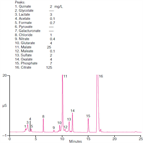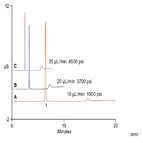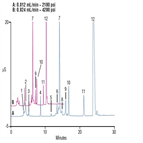Find methods for your needs
Refine by Feature
Displaying 1-4 of 4 results for Tag: monolith
AB137: Determination of Inorganic and Organic Acids in Apple and Orange Juice Samples Using Capillary IC
Instrument Type: ICDeterminations of organic acids in fruit juices are used by the beverage industry for flavor characterization, identification of spoilage, identification of adulteration by a less costly juice, and product labeling. In this study, inorganic anions and organic acids in diluted filtered apple and orange juice samples were determined on a Dionex IonSwift MAX-100 anion-exchange column using electrolytically generated hydroxide gradient from 0.1–65 mM KOH over 25 min at 15 μL/min.
TN113: Practical Guidance for Using Capillary Anion Chromatography - Concentrate Mode
Instrument Type: ICConfiguring a capillary IC system for trace analysis is discussed in this technical note, TN113. Tips and tricks for trace anion analysis for ion chromatography (IC) systems and capillary IC systems are discussed. Data is also shown for concentrating and direct injection of a large volume injection. This example demonstrates anion determinations by concentrating 200 uL of sample.
AN2967: Implementation of a Walk-Up High-Pressure Capillary Ion Chromatograph for the Fast Separation of Pharmaceutical Relevant Inorganic Anions (allergy tablet)
Instrument Type: ICThe API counter ion impacts the drug’s efficacy, solubility, and toxicity, and therefore counter ion determinations are important to pharmaceutical companies during all stages of product development and as part of product quality monitoring. In this example, the chloride counter ion is determined in a water extract of a pharmaceutical drug tablet designed for the treatment of seasonal allergic reactions. Here fast chloride determinations were demonstrated on IonSwift MAX-200 capillary column using a walk-up high pressure capillary IC system.
TN119: Fast Separations of Organic Acids in an Orange Juice Sample Using High-Pressure Capillary IC
Instrument Type: ICDeterminations of organic acid profiles in fruit juices are used in the beverage industry to characterize flavor, identify spoilage and potential sources of adulteration, and to meet labeling requirements for food products. In this study, inorganic anions and organic acids from a diluted orange juice sample are separated by anion-exchange chromatography on a capillary size IonSwift MAX-100 monolith IC column and detected by suppressed conductivity detection. For more information on organic acid determinations in fruit juices, please review AN143. An ICS-6000 can be used for this application.




